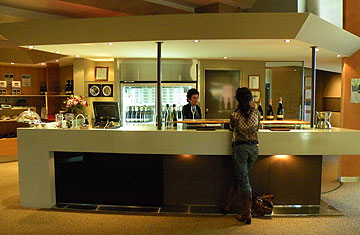
Vintage stuff The tasting bar at Tasmania's Jansz winery
Wild Tasmania is a motley mix of luxury yachters and weather-beaten trawler captains, intellectuals and outdoorsmen, conservative lumberjacks and leftie environmentalists, all making for a compelling social brew. Add a sprinkling of privacy-seeking celebrities, aswell as young creative types lured from mainland Australia by the high-quality lifestyle and affordable real estate, and you have the beginnings of a sophisticated cultural center and back-to-the-earth gourmet Eden.
The island's wine industry has been maturing to match, aided by a surprisingly diverse terroir that produces exceptionally elegant pinot noirs, excellent aromatic rieslings and delicately creamy sparkling chardonnays that stand up to the top champagnes. The refined, cool-climate wines produced in Tasmania's boutique wineries rarely leave the island, so you pretty much have to experience them in their pristine native habitat, one stop short of Antarctica. An easy drive to these three diverse estates gives an evocative taste of the current state of Tasmanian wine. After that you can head for the coast and take in the stunning orange-streaked rocks at the Bay of Fires. Or go west for a trek through the rainforest, a dip at Trial Harbor's vast sandy beach with its fairy penguins, a gander at the eccentric West Coast Pioneers Museum in Zeehan, where Houdini once straddled a tightrope over Main Street, and a visit to the cozy alpine spa at Cradle Mountain Lodge.
Jansz Tasmania
Bubbly is the hallmark of Tasmanian wine, and the venerable Jansz Vineyard (jansztas.com), directed by award-winning vintner Natalie Fryar, is devoted solely to premium sparklers. The pioneer of the "méthode Tasmanoise" is located in the northeastern Tamar Valley, where in the 1970s agricultural scientist Alfred Pirie found the red basalt soil and temperate climate ideal, with seasonal temperatures ranging from below those of Reims, in Champagne, to slightly above those of Burgundy and Alsace. The fussy pinot noir has found a nurturing home here in conditions promoting crisp mineral complexity and robust flavor. The long, cool ripening process allows the grapes to preserve the maximum concentration of aromatic compounds along with elevated natural acidity, for a soft lemony quality. Jansz's scintillating NV sparkling chardonnay combines delicacy with notes of fresh green apple, a suitable companion to the sweet juicy oysters of Bruny Island (where Captain William Bligh planted apple trees in 1788, just before the famous mutiny). If on the other hand you like a strawberry aroma, creamy texture, and gentle acidity, go for its premium NV sparkling rosé.
Delamere Vineyard
The Tamar Valley area is home to more than thirty vineyards, all scattered around the namesake estuary from the charming town of Launceston as far north as Pipers Brook. You will find the newly reinvented Delamere estate (delamerevineyards.com.au) a short drive through the rolling hills and past horse farms. Its young proprietor, Shane Holloway, bought the rustic family-run vineyard from Richard and Dallas Richardson in 2007 — along with an apple orchard, thirty chickens, sixteen guinea fowl, and a cellar door. Colder than the valley, the terrain is perfect for bubbly, and Delamare's wonderfully perfumed NV sparkling rosé is dry, subtle and complex, with raspberry notes that sneak up slowly to flirt with the back of your palate. We made the trip from Hobart just for the exceptional 2010 pinot noir rosé, which portrays the delicate essence of the grape in strong berry flavors accented by star anise and a crisp, dry finish. The 2006 blanc de blanc is a serious contender too: made entirely with chardonnay grapes in the methodé traditionnelle, it has an alluring nutty aroma coupled with candied-lemon fruitiness, earthy notes, and a creamy feel.
Moorilla
Hobart is the hub for the island's southern wine region and home to the fifty-year-old Moorilla Estate (mona.net.au/mona/winery), the first to plant pinot noir on the island. Overlooking the banks of the Derwent River, the winery is part of a slick resort complex that includes the spectacular underground Museum of Old and New Art (MONA), a gourmet restaurant, the Moo Brew microbrewery, Cellar Door tasting bar and futuristic guest accommodation. Since arriving in 2007, Canadian vintner Conor van der Reest has revamped the winery, introducing biodynamic principles and prioritizing quality over quantity, which has resulted in an 80 percent cut in production to 10,000 bottles per year. One of the best places to try Moorilla wine is at the estate's Source restaurant: the versatile Muse 2009 pinot noir has a rich, complex aroma with earthy floral, berry and spice notes that complement equally an entrée of poached bugs with raspberries and a main course of duck breast with mango, basil, and olive licorice. Riesling is another sterling island wine, and Moorilla's 2010 brut — produced under its Praxis label, which features fruitier, more straightforward wines best for early drinking — showcases crisp apple and lime highlights with a luxuriously smooth and lingering finish.
